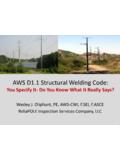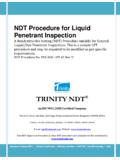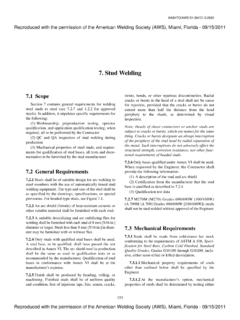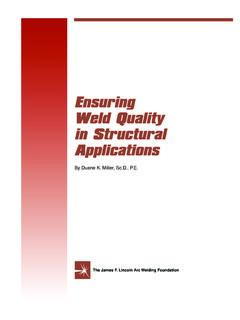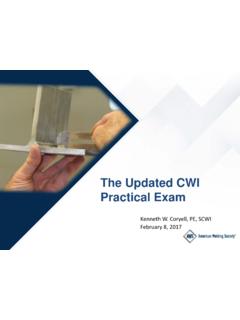Transcription of ARI 300 Tank Car and Underframe Structural Inspection …
1 ARI 300 Tank Car and Underframe Structural Inspection bulletin AMERICAN RAILCAR INDUSTRIES, INC. Issued 23 February 2016 1 Overview The information contained in this Inspection bulletin fundamentally explains the Inspection , test and acceptance criteria for the Structural integrity of the ARI 300 design stub sill series of tank car underframes as specified in 49 CFR Part 180, Subpart F, Qualification and Maintenance of Tank Cars. Tank car qualification programs require the Inspection of many areas common to all tank cars. These areas are clearly outlined in 49 CFR Part The requirements for a focused Inspection , which may be considered specific to the ARI style 300 stub sill Underframe , are outlined in the Specific Inspections section of this document. Additional references, including the AAR Manual of Standards and Recommended Practices, Specifications for Tank Cars, M-1002, the AAR Field Manual, and the AWS Railroad Welding Specification must be consulted in the development of a comprehensive qualification plan.
2 If any difference should exist between the aforementioned manuals and this bulletin , the manuals shall take precedence unless written instructions from American Railcar Industries, Inc. or the car owner exists. This document contains general Inspection requirements for the ARI 300 Series Underframe . Specific inspections must be performed in accordance with the car owner's qualification and maintenance program. ARI 300 Underframe Development The ARI 300 tank car Underframe was developed specifically to meet the industry need for interchange service tank cars that comply with the AAR fatigue life requirements. The Underframe consists of precisely designed fabricated steel components welded together to form a stub center sill and an underbelly cradle pad which is typically thick x 22 wide. The production of this design began in 1997 and continues to be produced. This Underframe has been updated several times since to assure that it continues to meet the AAR tank car environmental usage data.
3 The 300 series Underframe is currently in production. The most critical areas of the Underframe are at the inboard and outboard ends of the stub sill where it attaches to the tank cradle pads. The attachment welds of the cradle pad to the tank at the inboard and outboard terminations are also critical Inspection locations. ARI 300 Underframe , General Inspection Information All work must be performed in an AAR approved facility, and must be in accordance with the car owner s specific instructions, following all industry and shop safety procedures. Inspection personnel must be qualified in accordance with all FRA and AAR regulations including AAR MSRP CIII Appendix T. Note: Methods indicated in the following paragraphs are recommended methods and must not be interpreted as the only acceptable method. ARI 300 Tank Car and Underframe Structural Inspection bulletin AMERICAN RAILCAR INDUSTRIES, INC. Issued 23 February 2016 2 The defect acceptance criteria for the tank shell welding is to be in accordance with AAR Appendix W.
4 All other non-tank welding is to be in accordance with AWS Class 2. If questions arise concerning the integrity of any weld or the parent metal, then a more extensive test or Inspection may be required to obtain an accurate conclusion about the integrity of the area in question. If defects are present contact the maintenance responsible party for repair procedures. Figure 1: ARI 300 Underframe Inspection Locations and Codes ARI 300 Tank Car and Underframe Structural Inspection bulletin AMERICAN RAILCAR INDUSTRIES, INC. Issued 23 February 2016 3 Figure 2: ARI 300 Underframe View of Backstop to Sill Weld Specific Inspections: 1. Underframe General Inspection Inspect the sill and bolster for signs of abrasion, corrosion, cracks, dents, distortion, weld defects or any other condition that would make the tank car unsafe for transportation using one of the following Inspection and test procedures that the shop and inspector is certified to utilize: a) Dye penetrant test b) Radiography test c) Magnetic particle test d) Ultrasonic test e) Direct or remote visual Inspection f) Other applicable techniques which are authorized ARI 300 Tank Car and Underframe Structural Inspection bulletin AMERICAN RAILCAR INDUSTRIES, INC.
5 Issued 23 February 2016 4 The Inspection locations are to be reported using the TCID Data Collection Template ACF300 and ARI 300. This template applies to the ACF 300, ACF 301, ACF 310, ACF 330, ARI 300, ARI301, ARI310, ARI 330 underframes. 2. Cradle Pad to Tank Welds General Inspection Inspect the Structural tank attachment welds for cold-rolled terminations, cracks, undercuts and all other defects. Figure 1 shows the general construction, car specific dimensions should be used when cutting Inspection ports on jacketed cars. 3. Tank Girth Seam Butt Welds Ultrasonically inspect from the tank interior, the tank shell butt welds within 2 feet of the bottom longitudinal center line of the tank. The tank butt weld under the cradle pad is not a highly stressed weld, and by analysis has a low likelihood of failure. The weld must be inspected unless the owner has submitted reliability data to the FRA to exempt this weld from Inspection . 4. Rear Lug to Sill Welds Visually inspect from the tank exterior the fillet weld of the longitudinal rear lug reinforcement to the bottom of the sill top cover.
6 Inspect the adjacent rear lug reinforcement and sill top cover parent metal (4 places per car). See figure 2. 5. Sill Web to Cradle Pad Welds Inboard Termination For underframes not equipped with a reinforcement pad, visually inspect from the tank exterior, the last 6 of the inboard longitudinal fillet weld of the sill web to cradle pad, (B4, B44). Inspect the adjacent sill web and cradle pad parent metals (4 places per car). See figure 3. Cars not equipped with reinforcing pads (ACF 300 and ARI 300 are recommended to have them applied per the latest version of ARI Inspection bulletin , tank car inboard stub sill Inspection and modification (See ). 6. Reinforcement Pad to the Sill Web Welds For underframes equipped with a reinforcement pad, visually inspect from the tank exterior, the reinforcing pad at the inboard termination of the weld joining the sill web to the reinforcement pad. (B4, B44). Inspect the adjacent reinforcing pad parent metal (2 places per car). See figure 3.)
7 ARI 300 Tank Car and Underframe Structural Inspection bulletin AMERICAN RAILCAR INDUSTRIES, INC. Issued 23 February 2016 5 7. Reinforcement Pad to the Cradle Pad Welds For underframes equipped with a reinforcement pad, visually inspect from the tank exterior, the weld of the reinforcing pad to the cradle pad, (B301, B302). Also inspect the adjacent reinforcing pad parent metal (2 places per car). See figure 3. 8. Cradle Pad to Tank Welds Adjacent to Reinforcement Pad For underframes equipped with a reinforcement pad, visually inspect from the tank exterior, the cradle pad to tank weld along the length of the reinforcement pad. See figure 3. 9. Sill Web to Cradle Pad Webs Outboard Visually inspect, from the tank exterior, the last 6 of the outboard longitudinal fillet weld of the sill web to cradle pad, (B2, B22). Inspect adjacent sill web and cradle pad parent metals (4 places per car). See figure 3. ARI 300 Tank Car and Underframe Structural Inspection bulletin AMERICAN RAILCAR INDUSTRIES, INC.
8 Issued 23 February 2016 6 Figure 3: ARI 300 Underframe View of Sill Web to Cradle Pad ARI 300 Tank Car and Underframe Structural Inspection bulletin AMERICAN RAILCAR INDUSTRIES, INC. Issued 23 February 2016 7 10. Cradle Pad to Tank Welds Inboard Termination Visually inspect from the tank exterior, the last 6 of the inboard longitudinal fillet weld of the cradle pad to tank, (A6). Inspect the adjacent cradle pad and tank parent metal (4 places per car). See figure 4. Note: This Inspection area only applies to cars not equipped with a continuous cradle pad. Cars equipped with a slot weld from the cradle pad to the tank between the draft sill webs, (A8). Inspect the adjacent cradle pad and tank parent metal (4 places per car). See figure 4. Welds are longitudinal only and should not be welded around the radius on either end. 11. Head Pad to Tank Welds Visually inspect from the tank exterior, the radius area of the outboard cradle pad (head pad) to the tank head fillet weld (A1, A2).
9 Inspect the adjacent cradle pad and tank parent metal (2 places per car). See figure 4. 12. Head Pad to Tank Welds Inside the Head Block Ultrasonically inspect, from the tank interior, or through remote visual Inspection through the hole in the head block, the cradle pad (head pad) window to tank head fillet weld (A3). The cradle pad (head pad) window size is approximately transversely by longitudinally. The start of the window is located outboard of the tank head weld seam approximately 4 and is centered on the bottom center line of the tank (2 places per car). This weld is not a highly stressed weld and by stress analysis been determined to have a low likelihood of failure. The weld must be inspected unless the owner has submitted reliability data to the FRA to exempt this weld from Inspection . See figure 4. 13. Bolster Pad to Tank Welds This weld is included in the TCID template. Owners must base the need to inspect this area on reliability data. Visually inspect from the tank exterior, the weld around the radius portion of the bolster pad and one foot down from the tangent (A9, A10).
10 Inspect the adjacent cradle pad and tank parent metal (2 places per car). See figure 4. ARI 300 Tank Car and Underframe Structural Inspection bulletin AMERICAN RAILCAR INDUSTRIES, INC. Issued 23 February 2016 8 Figure 4: ARI 300 Underframe View of Reinforcement Pad to the Cradle Pad ARI 300 Tank Car and Underframe Structural Inspection bulletin AMERICAN RAILCAR INDUSTRIES, INC. Issued 23 February 2016 9 14. Head Block to Head Pad Welds Visually inspect from the tank exterior, the radius area of the outboard head block to cradle pad (head pad) fillet weld (D1). Inspect adjacent head block and cradle pad parent metal (4 places per car). See figure 5. 15. Head Block to Sill Web Welds Visually inspect from the tank exterior, the welds which attach the head block to the sill web including that portion of the weld that extends across the sill top cover (C2, C3). Note that the vertical groove weld is approximately 1 long (C3). Inspect the adjacent head block and sill web parent metal (4 places per car).



